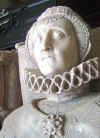

Magdalen DACRE
(V. Montague)
Born: Jan 1538, Naworth Castle, Cumberland, England
Died: 8 Apr 1608, Battle Abbey, Sussex, England
Buried: Midhurst Church, Sussex, England
Father: William DACRE (3º B. Gillesland/ 2º B. Greystoke)
Mother: Elizabeth TALBOT (B. Gillesland)
Married: Anthony BROWNE (1º V. Montague) 15 Jul 1558, St. James’s Palace
Children:
1. Phillip BROWNE (b. 1559)
5. Jane BROWNE
6. Mary BROWNE
8. Mabel BROWNE
9. Thomas BROWNE
10. William BROWNE
Effigy of Magdalen Dacre´s tomb
Daughter of William Dacre, third baron Dacre of Gillesland, by his wife, Elizabeth, daughter of George Talbot, fourth Earl of Shrewsbury, sister of Thomas, fifth Baron Dacre, she was born in Jan 1538 at Naworth Castle in Cumberland. At thirteen, she was a gentlewoman to Anne Sapcote, Countes of Bedford, wife of Sir John Russell, first Earl of Bedford, and at sixteen joined Queen Mary’s household, and was her intimate friend and confidante.
She was one of Mary’s bridesmaids when she married Felipe II of Spain. Magdalen was reportedly very religious, spending much of her time in prayer and wearing a coarse linen smock under her court clothes.
According to a story repeated in E.S. Turner’s The Court of St. James and elsewhere, she was a blonde, a head taller than any other maid of honor, and very attractive, and she caught the attention of Mary’s husband, Felipe II of Spain. The story goes that Felipe opened a window to a room where Magdalen was washing her face (or in some versions, brushing her hair) and, supposedly in jest, caught hold of her. Magdalen beat him off with a nearby staff and neither she nor her mistress found the incident amusing.
On 15 Jul 1558, Magdalen was married at St. James’s palace to Anthony Browne, Viscount Montague. Magdalen raised two stepchildren and had ten children of her own. Magdalen and her husband were recusants during the reign of Elizabeth and her husband was questioned when Magdalen’s brother, Leonard, took part in the Northern Rebellion of 1569, but in general they were left alone by the government, even though they had resident chaplains who celebrated mass for as many as 120 people on special occasions. Magdalen was only once accused of recusancy, her house was searched only twice, and only once was one of her priests taken and imprisoned. She was willing to allow a printing press on her premises, but would not aid treasonous plots, not even those of another brother, Francis. Her chaplain at Cowdray was Thomas More, grandson of the martyr.
When Queen Elizabeth visited Cowdray for a week in 1591, the priests were hidden and George Browne was knighted.
Magdalen lived at Battle Abbey at her husband's death. After 1592, the widower William Brooke, Lord Cobham, courted the widow Magdalen Dacre, but she declined his offers. In 1597, when a messenger brought a letter there to be passed on to the Earl of Essex, Magdalen turned the messenger over to the magistrate and also reported the incident to Lord Buckhurst, a privy councilor, sending her niece along as a witness. At the same time, a house at the edge of Battle manor contained a subterranean passage by which priests were smuggled into England.
Magdalen Dacre died at Battle Abbey, Sussex on 8 Apr 1608 at the age of seventy. She was originally buried in Midhurst Church, where a splendid tomb with her effigy was erected. The tomb was moved in 1851 to Easebourne Church.
 to Bios Page
to Bios Page |
|
 to Peerage Page
to Peerage Page |
 to Home Page
to Home Page |